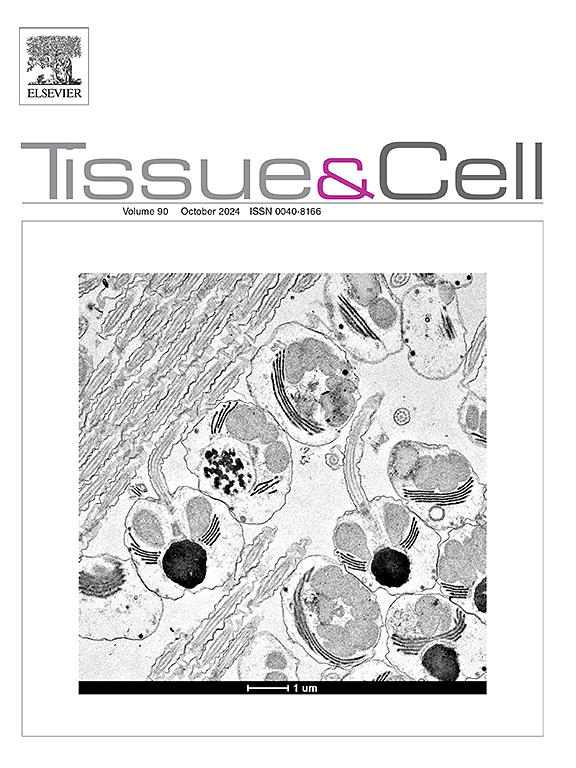Pinobanksin ameliorates perfluorooctane sulfonate-evoked cardiotoxicity via targeting Nrf-2/Keap-1, oxidative damage and inflammation in Sprague Dawley rats
IF 2.7
4区 生物学
Q1 ANATOMY & MORPHOLOGY
引用次数: 0
Abstract
Perfluorooctane sulfonate (PFOS) is a potent environmental toxicant which affects crucial organs of the body including the heart. Pinobanksin (PBN) exhibits marvelous medicinal values owing to its excellent therapeutic properties. This investigation was executed to assess the curative potential of PBN against PFOS instigated cardiac dysfunction in rats. Twenty-four albino rats (Rattus norvegicus) were apportioned into 4 groups including the control, PFOS (10 mgkg-1), PFOS (10 mgkg-1) + PBN (20 mgkg-1) and PBN (20 mgkg-1) alone provided group. Our findings showed that PFOS intoxication reduced the activities of glutathione reductase (GSR), superoxide dismutase (SOD), glutathione peroxides (GPx), glutathione S-transferase (GST), Heme Oxygenase-1 (HO-1) and catalase (CAT) while reducing the concentrations of malondialdehyde (MDA) and reactive oxygen species (ROS). Moreover, PFOS intoxication increased the concentrations of creatine kinase-myocardial band (CK-MB), creatine phospho-kinase (CPK), lactate dehydrogenase (LDH) and troponin I. Furthermore, cardiac inflammation was provoked after PFOS provision that was evident by augmented levels of pro-inflammatory markers. The administration of PFOS upregulated the expressions of Bcl-2–associated X protein (Bax) and cysteine-aspartic acid protease-3 (caspase-3), while reducing the expressions of B-cell lymphoma protein 2 (Bcl-2). Nonetheless, the histopathological analysis showed significant cardiac damage after PFOS intoxication. However, PBN treatment alleviated cardiac impairments because of its tremendous oxidation curtailing properties.
Pinobanksin通过靶向Nrf-2/Keap-1、氧化损伤和炎症改善全氟辛烷磺酸引起的Sprague Dawley大鼠心脏毒性
全氟辛烷磺酸(PFOS)是一种强效环境毒物,会影响包括心脏在内的人体重要器官。Pinobanksin (PBN)因其优异的治疗性能而具有非凡的药用价值。本研究旨在评估PBN对PFOS诱导的大鼠心功能障碍的治疗潜力。将24只褐家鼠分为对照组、PFOS (10 mgkg-1)组、PFOS (10 mgkg-1) + PBN (20 mgkg-1)组和PBN (20 mgkg-1)单独提供组。结果表明,PFOS中毒降低了谷胱甘肽还原酶(GSR)、超氧化物歧化酶(SOD)、谷胱甘肽过氧化物(GPx)、谷胱甘肽s转移酶(GST)、血红素加氧酶-1 (HO-1)和过氧化氢酶(CAT)的活性,同时降低了丙二醛(MDA)和活性氧(ROS)的浓度。此外,全氟辛烷磺酸中毒增加了肌酸激酶-心肌带(CK-MB)、肌酸磷酸激酶(CPK)、乳酸脱氢酶(LDH)和肌钙蛋白i的浓度。此外,全氟辛烷磺酸引起心脏炎症,这可以通过促炎标志物水平的增加来证明。PFOS上调Bcl-2相关X蛋白(Bax)和半胱氨酸-天冬氨酸蛋白酶-3 (caspase-3)的表达,降低b细胞淋巴瘤蛋白2 (Bcl-2)的表达。尽管如此,组织病理学分析显示PFOS中毒后心脏损伤明显。然而,PBN治疗由于其巨大的氧化抑制性能而减轻了心脏损伤。
本文章由计算机程序翻译,如有差异,请以英文原文为准。
求助全文
约1分钟内获得全文
求助全文
来源期刊

Tissue & cell
医学-解剖学与形态学
CiteScore
3.90
自引率
0.00%
发文量
234
期刊介绍:
Tissue and Cell is devoted to original research on the organization of cells, subcellular and extracellular components at all levels, including the grouping and interrelations of cells in tissues and organs. The journal encourages submission of ultrastructural studies that provide novel insights into structure, function and physiology of cells and tissues, in health and disease. Bioengineering and stem cells studies focused on the description of morphological and/or histological data are also welcomed.
Studies investigating the effect of compounds and/or substances on structure of cells and tissues are generally outside the scope of this journal. For consideration, studies should contain a clear rationale on the use of (a) given substance(s), have a compelling morphological and structural focus and present novel incremental findings from previous literature.
 求助内容:
求助内容: 应助结果提醒方式:
应助结果提醒方式:


